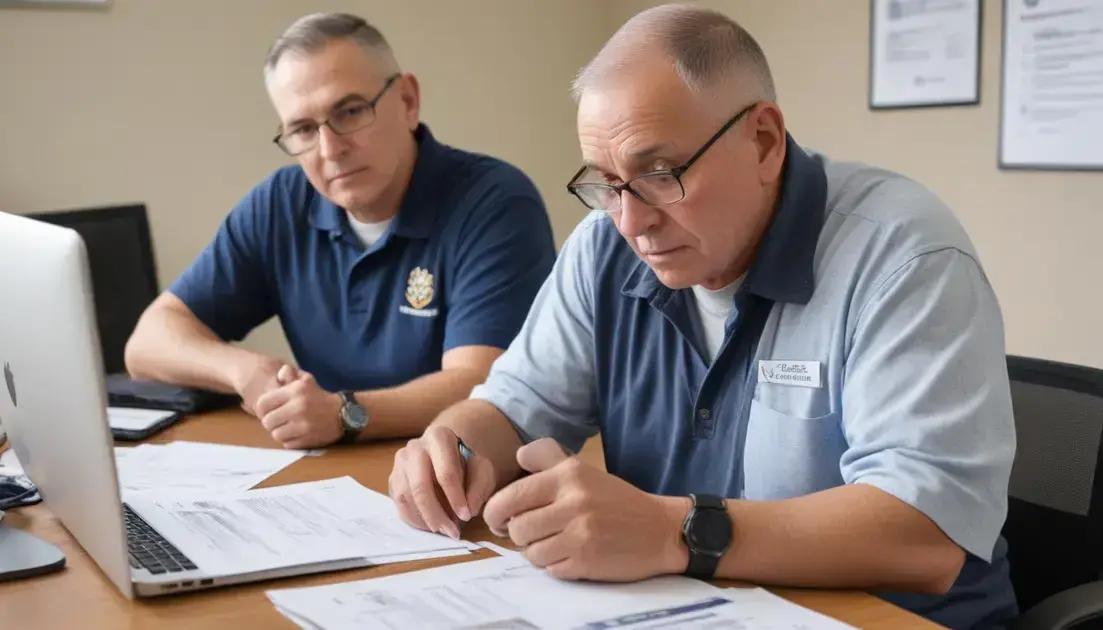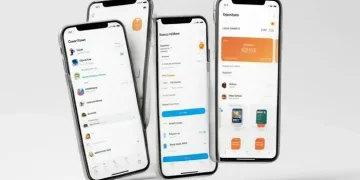Veterans benefits: uncovering the support you deserve

Did you know that veterans benefits can transform your life? From healthcare to education, these programs are designed to honor your service. Let’s explore what’s available and how you can access them.
Understanding veterans benefits: an overview
Veterans benefits are designed to support those who have served in the military, offering financial, medical, and educational assistance. These programs recognize the sacrifices made by service members and provide essential resources to help them transition back to civilian life.
Types of Veterans Benefits
There are several key categories of veterans benefits, including healthcare, education, disability compensation, and housing assistance. Each program has specific eligibility requirements, so it’s important to understand which benefits you qualify for.
For example, the GI Bill helps veterans pay for college or vocational training, while VA home loans make it easier to buy a house with no down payment. Disability compensation provides monthly payments to veterans with service-related injuries or illnesses.
How to Access These Benefits
Applying for veterans benefits can seem overwhelming, but the process is straightforward with the right guidance. Start by gathering necessary documents, such as your DD-214 form, medical records, and proof of income. The VA website and local veterans service organizations can help you navigate the application process.
Many veterans miss out on benefits simply because they don’t know they’re eligible. Whether you served recently or decades ago, it’s worth exploring what support is available to you.
Healthcare benefits for veterans
Healthcare benefits for veterans provide comprehensive medical coverage through the VA health system. Eligible veterans can access services ranging from primary care to specialized treatments, often at little or no cost.
Types of VA Healthcare Services
The VA offers preventive care, mental health services, prescription medications, and even telehealth options. Veterans with service-connected disabilities may qualify for priority care and additional benefits like prosthetics and rehabilitation services.
For example, the VA MISSION Act expanded options for community care when VA facilities aren’t easily accessible. This means veterans can receive approved care from local providers while the VA covers the costs.
Eligibility Requirements
Most veterans who served on active duty and received an honorable discharge qualify for some level of VA healthcare. Priority groups are based on factors like service-connected disabilities, income level, and military service history.
Enrollment is simple – veterans can apply online, by phone, or in person at any VA medical center. Bringing your DD-214 and income information will help speed up the process.
Specialized Programs
The VA provides unique programs like women’s health services, geriatric care, and treatment for military sexual trauma. There are also special initiatives for homeless veterans and those struggling with substance abuse.
Many veterans don’t realize they qualify for these benefits. Even if you have private insurance, VA healthcare can serve as an affordable supplement covering services your regular plan might not.
Education and training opportunities
Education and training opportunities for veterans provide powerful tools to transition to civilian careers. The GI Bill and other programs offer financial support for college degrees, vocational training, and certification programs.
GI Bill Benefits Explained
The Post-9/11 GI Bill covers tuition, housing allowances, and book stipends for approved education programs. Veterans can use these benefits at universities, community colleges, and even for on-the-job training or apprenticeships.
For example, the Yellow Ribbon Program helps cover costs at private institutions that normally exceed GI Bill limits. Many veterans don’t realize they can transfer unused benefits to spouses or dependents under certain conditions.
Vocational Rehabilitation (VR&E)
This program helps service-disabled veterans prepare for, find, and maintain suitable employment. Services include career counseling, resume help, job training, and even startup support for those wanting to begin their own businesses.
The VA also partners with hundreds of employers through the Veterans Employment Center, connecting qualified veterans with job opportunities matching their military experience.
Specialized Training Programs
Unique opportunities exist for veterans interested in high-demand fields like healthcare, technology, and skilled trades. Programs like VET TEC provide technology education without using GI Bill benefits, while Helmets to Hardhats helps veterans enter construction careers.
Many community organizations offer free coding bootcamps and career transition programs specifically designed for veterans. These intensive programs can launch new careers in just months rather than years.
Housing and home loan programs
Housing and home loan programs offer veterans some of the most valuable benefits available, with the VA home loan program being one of the most popular. These programs help veterans purchase, build, or refinance homes with favorable terms.
VA Home Loan Benefits
The VA home loan program requires no down payment and no private mortgage insurance (PMI), with competitive interest rates. Veterans can use this benefit multiple times, either to buy new homes or refinance existing mortgages through the VA Interest Rate Reduction Refinance Loan (IRRRL).
For example, the VA Loan Guaranty means the VA backs a portion of the loan, allowing lenders to offer better terms. Many veterans don’t realize they may still qualify even with less-than-perfect credit.
Special Housing Grants
Veterans with certain service-connected disabilities may qualify for Specially Adapted Housing (SAH) grants. These grants help modify or build accessible homes to accommodate disabilities, with benefits up to $101,754 in 2023.
The VA also offers temporary residence adaptation (TRA) grants for veterans needing to live with family during home modifications, and home improvement structural alteration (HISA) grants for necessary medical improvements.
Avoiding Foreclosure Help
The VA provides assistance through its Loan Guaranty Service to help veterans facing financial difficulties keep their homes. Options include repayment plans, loan modifications, and in some cases, refunding of a VA loan to avoid foreclosure.
Many state and local programs offer additional benefits like property tax reductions for disabled veterans. It’s worth checking with your county assessor’s office for potential savings on your primary residence.
Disability compensation explained

Disability compensation provides tax-free monthly payments to veterans who got injured or developed illnesses during their military service. The amount depends on your disability rating, which ranges from 0% to 100% in 10% increments.
Understanding Disability Ratings
The VA assigns ratings based on medical evidence showing how much your condition reduces your overall health and ability to work. Multiple disabilities are combined using a special formula, not simply added together. For example, a 50% and 30% rating don’t equal 80% – the combined value would be 65% (rounded to 70%).
Common Qualifying Conditions
Many veterans don’t realize common issues like tinnitus (ringing in ears), hearing loss, back pain, PTSD, and sleep apnea often qualify for compensation. Even conditions that appear years after service may be connected if you can show they’re related to military duties.
The Claims Process
Filing a successful claim requires three key elements: 1) a current diagnosis, 2) evidence of an in-service event or injury, and 3) a medical connection between them. The VA’s Duty to Assist helps gather evidence, but providing complete medical records upfront speeds up decisions.
Veterans can file claims online through VA.gov, with help from Veterans Service Organizations (VSOs), or through accredited claims agents. The process typically takes 3-6 months but may be faster for fully developed claims with all supporting documents.
Special Compensation Types
Beyond basic disability pay, veterans may qualify for additional benefits like: Individual Unemployability (pay at 100% rate if unable to work), Special Monthly Compensation (for severe disabilities like limb loss), or Aid and Attendance (for needing daily living help).
Employment support for veterans
Employment support for veterans includes specialized programs to help transition military skills to civilian careers. The Veterans’ Employment and Training Service (VETS) offers resources from resume building to job placement assistance.
Federal Hiring Preferences
Veterans receive preference points when applying for federal jobs, with disabled veterans getting additional advantages. Many government agencies have special hiring authorities just for veterans, bypassing competitive processes.
The Veterans Recruitment Appointment (VRA) allows agencies to non-competitively hire eligible veterans up to GS-11 level positions. After two years, these positions convert to competitive status.
Corporate Hiring Programs
Major companies like Amazon, Microsoft, and JPMorgan Chase run veteran hiring initiatives. These programs often include skills translation services, mentorship, and leadership tracks recognizing military experience.
The Hiring Our Heroes corporate fellowship places transitioning service members in 12-week internships with Fortune 500 companies. Over 75% of participants receive job offers upon completion.
Entrepreneurship Resources
The VA’s Office of Small & Disadvantaged Business Utilization helps veteran-owned businesses compete for government contracts. The Boots to Business program provides free entrepreneurship training through the SBA.
Veteran Business Outreach Centers offer counseling, training, and technical assistance in all 50 states. Many states offer additional benefits like tax incentives for hiring veterans or certification programs for veteran-owned businesses.
State-Specific Benefits
Nearly every state offers veteran employment programs beyond federal benefits. These may include occupational licensing fee waivers, apprenticeship opportunities, or tax credits for employers hiring veterans.
Pension benefits for eligible veterans
Pension benefits for eligible veterans provide monthly payments to wartime veterans with limited income who are permanently disabled or over age 65. Unlike disability compensation, these benefits are needs-based and don’t require service-connected conditions.
Basic Eligibility Requirements
To qualify, veterans must have served at least 90 days active duty with at least one day during wartime periods. They must meet income and net worth limits set annually by Congress, and be permanently disabled or age 65+.
The VA pension program has three tiers: Basic Pension, Housebound benefits (for those substantially confined to home), and Aid & Attendance (for those needing daily living assistance). Each provides progressively higher payment amounts.
Income and Asset Rules
The VA counts most income sources including Social Security and retirement payments, but excludes certain medical expenses. Net worth includes assets like bank accounts and investments, but not your primary home or vehicle.
Many veterans don’t realize they can reduce countable income by deducting unreimbursed medical expenses. This includes insurance premiums, assisted living costs, and in-home care expenses not covered by insurance.
Survivors Pension Benefit
Low-income surviving spouses and dependent children of deceased wartime veterans may qualify for Death Pension benefits. Eligibility depends on the veteran’s service, the survivor’s income, and marital status at time of death.
Unlike Dependency and Indemnity Compensation (DIC), the Survivors Pension doesn’t require the veteran’s death to be service-connected. However, income limits are typically lower than the regular VA pension program.
Application Process
Veterans can apply for pension benefits using VA Form 21-527EZ, available online at VA.gov. Required documents include discharge papers, medical evidence, and financial information. Processing typically takes 6-12 months.
Burial and memorial benefits
Burial and memorial benefits honor veterans’ service with dignified interment options and lasting tributes. The Department of Veterans Affairs provides these benefits at no cost to eligible veterans and their families.
National Cemetery Benefits
Eligible veterans may receive burial in one of 155 national cemeteries, which includes a gravesite, opening/closing of the grave, perpetual care, a government headstone or marker, and a burial flag. Spouses and dependent children may also be eligible for burial in national cemeteries.
The VA National Cemetery Scheduling Office coordinates burials at no cost to the family. Many veterans don’t realize they can request a specific national cemetery, though availability depends on space at the chosen location.
Headstones and Markers
The VA provides government-furnished headstones or markers for veterans’ graves worldwide, regardless of burial location. Families can choose from various styles including flat bronze, flat granite, upright granite, and niche markers for columbaria.
For cremated remains, the VA offers memorial headstones when ashes are scattered or kept by the family. These memorials can be placed in national cemeteries or private cemeteries with permission.
Presidential Memorial Certificates
This program provides an engraved certificate signed by the current President to honor deceased veterans. Families can request certificates online, by mail, or through a VA regional office, with no limit on the number that may be requested.
The certificates don’t indicate the veteran’s branch of service or rank, emphasizing equal honor for all who served. They make meaningful keepsakes for multiple family members.
Burial Allowances
The VA may reimburse some burial and funeral costs through two types of payments: a burial and plot interment allowance (up to $2,000 for service-connected deaths) and a non-service connected burial allowance (up to $796 plus $796 for plot).
To claim these benefits, families should submit VA Form 21P-530 within two years of permanent burial. The VA also provides a transportation benefit for service-connected deaths requiring movement to a national cemetery.
How to apply for veterans benefits step-by-step
Applying for veterans benefits can seem overwhelming, but breaking it down into clear steps makes the process manageable. Whether you’re seeking healthcare, education benefits, or disability compensation, these steps will guide you through the application process.
Step 1: Gather Required Documents
Start by collecting your DD-214 discharge papers, medical records, marriage certificate (if applicable), and any supporting evidence for your claim. Having these documents ready will significantly speed up your application.
For disability claims, you’ll need medical evidence connecting your condition to military service. This can include service treatment records, private medical records, and buddy statements from fellow service members.
Step 2: Create Your VA.gov Account
The VA’s online portal at VA.gov is the fastest way to apply for most benefits. You’ll need to verify your identity through Login.gov or ID.me to access all features. This secure account lets you track claims, upload documents, and check benefit status.
If you prefer paper applications, you can download forms from the VA website or request them by calling 1-800-827-1000. However, online applications typically process faster.
Step 3: Complete the Appropriate Application
Each benefit has its own application form:
• VA Form 21-526EZ for disability compensation
• VA Form 10-10EZ for healthcare
• VA Form 22-1990 for education benefits
• VA Form 26-1880 for home loans
The VA’s online application wizard will guide you through the correct form based on your needs. Answer all questions completely and honestly to avoid delays.
Step 4: Submit Supporting Evidence
Upload or mail any additional documents that strengthen your claim. For disability claims, this might include private medical records, employment information showing how your condition affects work, or statements from family about your symptoms.
The VA’s Fully Developed Claim program offers faster processing if you submit all evidence upfront. Consider working with a Veterans Service Organization (VSO) to ensure your application is complete.
Step 5: Track Your Claim Status
After submitting, you can check your claim status through your VA.gov account. The VA will schedule any needed exams and may request additional information. Typical processing times range from 3-12 months depending on benefit type and claim complexity.
If your claim is denied, you have one year to appeal the decision. Many successful claims require persistence through the appeals process.
Navigating Your Veterans Benefits Journey
Understanding and accessing veterans benefits can significantly improve your quality of life after service. From healthcare to education, housing to disability compensation, these programs exist to honor your sacrifice and support your transition to civilian life.
While the application process may seem complex at first, breaking it down into manageable steps makes it approachable. Remember that you don’t have to navigate this system alone – VA representatives and veterans service organizations stand ready to help.
The benefits you’ve earned through your service can open doors to new opportunities, provide crucial financial support, and ensure you receive the care you deserve. Whether you served recently or decades ago, it’s never too late to explore what assistance might be available to you.
Your service mattered. These benefits are one way our nation says thank you. Take that first step today to claim what you’ve rightfully earned.






